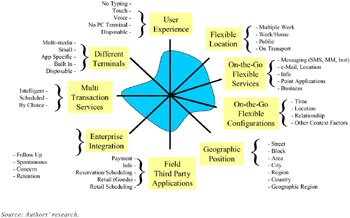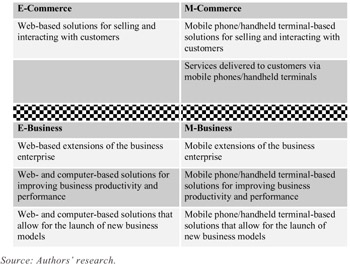M-Business: Advantages and Enhancements Over E-Business
|
E-business has conquered the world. Despite the bursting of the dot.com bubble, it is hard to believe today how one managed to transact any business in the early 1990s without the Internet. Whether employed for information, support, or advertising, nearly every business in the world of any size has a Web site. E-commerce has revolutionized how many companies do business, allowing for new business models and spawning completely new types of businesses. So with e-business less than 10 years old, is the world ready for something new, something with the potential to revolutionize business practices the way e-business did? The answer is "Yes."
Like e-business that preceded it, m-business as a transformational force is here to stay. In the next few years, m-business will emerge as a powerful new approach for conducting business. The initial years will be spent solving some of the challenges associated with the new m-business paradigm—usage and user patterns, creating optimal terminal types, and evolving sustainable business models. But after this is accomplished, m-business will become as pervasive as e-business has become today. While the transformation induced by m-business would be dramatic, it would not necessarily replace e-business. M-business would enhance existing e-business functions and applications and launch new ones, totally mobile instead of being tied to desktop terminals. In many ways, m-business would establish new patterns of doing electronic transactions, over and beyond what fixed-line e-business is capable of.
E-business happened because of the combined efforts of the personal computer (PC), telecommunications, business software, and office technology industries. M-business, similarly, will happen because of the combined efforts of the world's mobile handset manufacturing, telecommunications, computers, software, and office technology industries. The Internet and e-business made the PC industry grow to a level where PC makers were shipping 100 million PC units every year by 2002. Even without a significant m-business base, by 2002, the mobile handset makers were already shipping 400 million units every year. In this massive global business, m-business is appearing as a new platform for creating product and service differentiation. Internet and e-business helped drive the supply and demand for multimedia computers. The underlying chip and display technology required for m-business is in its infancy, with the first "primitive" (by future standards) multimedia/application-capable terminals introduced in 2002. As m-business matures, it would transform the handset, rendering it as different from its predecessors as today's desktop PC screen is from the green-tinted, nongraphic PC screen of the early 1980s.
So what do we understand by m-business and by m-commerce? Parallels are drawn between e-business/e-commerce and m-business/m-commerce in Table 1. The descriptions in Table 1 are generalized and may give the impression that the only thing m-business does is replace the PC-based Web access with mobile phone/handheld terminal-based access. The Wireless Application Protocol (WAP), commonly viewed as a failure (at least in its initial version), provided a Web browser optimized for mobile phone and handheld terminal use. Among many reasons for the initial troubles of WAP was that it force-fit desktop-oriented screen content into small terminals. If m-business were merely an extension of the desktop e-business into handheld devices, then its role would be limited.
|
|
The analogies in Table 1, derived from the perspective of today's e-business, are inherently limiting. Under this frame of thinking, m-business would simply extend e-business to the mobile terminal. This fails to take into account that the "m" is fundamentally different from the "e". A simple look at the vibrant consumer market for cell phones provides some clues. In this dynamic marketplace—visible especially in the electronic retail districts of cities like Tokyo, Hong Kong, and Singapore—hundreds of colorful models compete for the consumer (and business persons' attention), with new models brought out every month. The PC, on the other hand, basically looks like it has for the past 20 years, with only one or two dramatic innovations—usually introduced by Apple Computers—along the way. A look at Figure 1 hints why this is the case. Out of the 10 experience/function variables that m-business will draw its power from, e-business (and e-mail) can deliver at best only four or five, and some of those are delivered with severe limitations.

Figure 1: M-Business and E-Business Distinctions Viewed in an Experience/ Function Framework
M-business's ability to draw on all of these experience/function variables (and some that have not yet been imagined) is the key to its revolutionary power. The best way to describe this is to say that m-business solutions 10 years from now will be as dramatically different from today's terminal and e-business applications as today's multimedia PC is from the teletype interfaces to mainframe or minicomputers of the 1970s.
In the following paragraphs, we provide short descriptions of each of the 10 experience/function variables that are likely to set m-business apart from e-business.
User Experience
Perhaps the biggest differentiator between e-business and m-business is the sensory experience of the user. In e-business, the user is in a stationary position in front of a PC terminal and interfaces the content using a keyboard and point-and-click devices. In m-business, this is replaced by total mobility, and the terminal can be voice or touch activated.
Different Terminals
A disposable terminal is probably the most radical way of describing how different terminals could be. This is not a farfetched idea—in 1990, no one would have thought of a disposable camera. Today's manufacturing technology aided by the unrelenting progress of Moore's Law [2] will allow an ever-increasing differentiation of terminal offerings. Terminals that are bendable, so that they can be rolled up, have been demonstrated at trade shows. Miniature-sized terminals allow for packaging into ever-changing shapes and forms. Prepaid phone service is just the introduction to other prepaid services, complete with "free" terminals. Multimedia is here to stay and will continue to evolve.
Multitransaction Services
M-business services could be scheduled and delivered in multiple ways. Users can choose to have a variety of services delivered at the times and places that they specify. In some cases, the services can be prescheduled (for peak hours, late night, birthdays, etc.). In still other cases, the network and the device can make intelligent assessments of what services are needed and then proffer such services.
Integration with Enterprise Applications
With m-business, a business enterprise could move most of its capabilities out into the field. Services and applications that required office visits and meetings could now be delivered on the go, with full access to all enterprise applications residing on business IT and information systems.
Field Third-Party Applications
Terminals that are m-commerce ready can receive services not just from the primary wireless service providers but also from a variety of third-party providers. Most of these third-party providers would work through the wireless service operators. In some cases, the terminal may be able to communicate directly to third-party wireless service providers, through ad-hoc information exchange setups or direct connectivity. The source of applications and information therefore becomes transparent to the user.
Geographic Positioning
From a continent to the corner of a street, m-commerce networks would be able to locate the user and tailor the service mix to the geographical location, keeping in view the constraints and opportunities of the geographical setting as well as the preferences of the user. A service would therefore work differently in Singapore than in Hong Kong, London, or New York based on profiles or regional preferences.
On-the-Go Flexible Configurations
Today's user profiles, whether in e-business or m-business settings, show the way to flexible configurations. But rather than requiring manual setups and changes, the m-services of the future will be automatically configured. So the minute a user leaves the home area, the service will be automatically configured with ring-tones, forwarding information and even downloaded information as the user travels. And should the user want to configure it in a new way, a simple code will download a new configuration. This would be the world of hundreds of prepackaged user experiences ready to be activated.
Integration with Mobile Services
New m-business services would be easy to integrate with preexisting mobile services. For example, m-business offerings could easily incorporate a variety of existing messaging services, short message service (SMS), and e-mail. They could also use conference bridges, network-based calling, voice mail, as well as many emerging services, like downloadable handset applications, multimedia messaging, and information services.
On-the-Go Flexible Services
With easier integration of services, users would be able to avail of prepackaged as well as programmable service mixes. Some m-business systems would offer a service palette from which the users would be able to choose and blend a variety of services.
Flexible Location
With m-business, the user can work, do daily chores, and play, at work, home, recreational, shopping, and vehicular locations. The coming blurring of roles in the era of m-business will spawn multiple opportunities as well as trigger major social changes.
[2]This refers to the exponential decline in costs, and therefore prices, of information technology (IT) as a result of advancements in technological platforms and manufacturing methods. The name is derived from Gordon Moore, cofounder of Intel, who first commented on this phenomenon with respect to semiconductors.
|
EAN: 2147483647
Pages: 139
